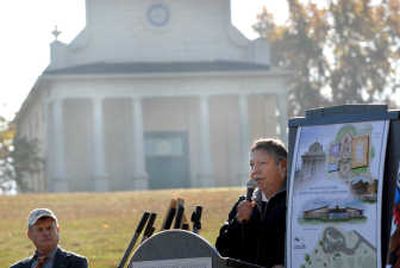Comprehending contact

CATALDO, Idaho – No longer will the Coeur d’Alene Tribe keep the history of its intersection with Jesuit missionaries in storage, out of view of tribal youth and the world.
This complex and often contentious story soon will become a permanent part of the Coeur d’ Alenes’ Old Mission State Park in Cataldo, open for all to see.
In two weeks, crews will tear down the cramped visitors center next to the Cataldo Mission – the ground along the Coeur d’Alene River where the European and American Indian cultures collided in the 1840s.
In its place, from the dirt that tribal leaders, priests and locals blessed Tuesday with Native songs, prayer and tobacco, will rise a new center with a 5,000-square-foot exhibition space for “Sacred Encounters: Father DeSmet and the Indians of the Rocky Mountain West.” The building is expected to open in spring 2009.
“It’s good for our people,” Coeur d’Alene elder Milton Nomee told the 70 people gathered below the mission for the groundbreaking ceremony. “For many years our history has been in boxes. Now it can come out for everyone to see.”
The $3.8 million project is nearly 14 years in the making and was thought dead just a few months ago. The dream of the new visitors center and permanent exhibit, which offers a blunt assessment of tribal-Catholic relations over the past 160 years, was saved this summer by Coeur d’Alene tribal elders. The elders persuaded the tribal council to donate the remaining $1.5 million.
“It’s these people’s history we want to preserve,” said Jackie Peterson, a Washington State University-Vancouver history professor who designed the original “Sacred Encounters” exhibit that began a four-year tour in 1993. The exhibit, which strives to understand the interaction between the two dramatically different cultures, never visited North Idaho or Spokane, she said.
Tribal elders, priests and longtime mission supporter Harry Magnuson, a Wallace businessman, traveled to see the exhibit in Bozeman. Other tribal members saw it in Portland. Peterson said elders wept and wanted to preserve the exhibit so their history isn’t lost.
That’s how the idea for the Cataldo project began. In 1998, the nonprofit Association for Sacred Encounters formed to raise the money to reassemble the original exhibit and give it a permanent home at the Cataldo Mission. The group included representatives of the tribe, Idaho Parks and Recreation, Gonzaga University, WSU and the Northwest Museum of Arts and Culture.
“It’s a righteous project,” said Ernie Stensgar, of the Coeur d’Alene Tribal Council. “I always look at Cataldo as a beacon to all the visitors that pass though.”
Traffic on Interstate 90 rumbled in the background Tuesday as Stensgar spoke. The freeway helps bring more than 100,000 people annually to the mission, the most visited heritage park in the state.
Magnuson, who donated money to the project and has been involved in preserving the mission since the 1960s, teared up as he spoke of the benefits of the new center and exhibit. Magnuson’s grandfather, an immigrant miner, spent the winter of 1893 at the mission when the economy tanked and the mines closed.
“It’s a lasting memorial for generations to come,” he said. “It’s something to preserve the culture and history of the area.”
Father Pierre-Jean DeSmet was one of the first Jesuits to reach Rocky Mountain tribes, with the goal of converting Indians spiritually and economically. Funded in part by the U.S. government, the Jesuits established missions and brought new agricultural practices.
For many tribes in the Inland Northwest, the Jesuits fulfilled an ancient prophecy that a group of men in black robes one day would cross the mountains and teach a new spiritual life, filled with ritual and song.
But while some embraced the new religion, other members of the Coeur d’Alene and Salish tribes resisted the concepts of sin and hell and conforming to the European values by which Jesuits lived. The new religion created a cultural schism among the tightly knit Coeur d’Alenes.
The exhibit will use historical documents and personal accounts to reconstruct the shifting relationship between Jesuit and tribal leaders.
Jesuit schools, which were established at the request of the Coeur d’Alenes, banned the native language and stifled tribal heritage until their closure in the 1970s.
On Tuesday as the sun burned off the fog over the mission, Stensgar said it was a sign from his people who lived the history at the mission.
“It had a lot to do with them smiling down on us today as we break ground here,” he said.